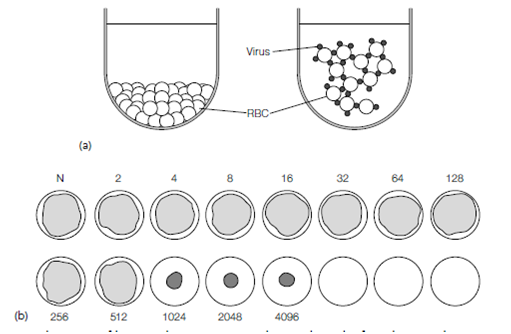Hemagglutination
Many viruses (including influenza virus) have the ability to agglutinate red blood cells (RBCs), a phenomenon known as hemagglutination, by linking cells together such that they form a mesh or network. In order for the reaction to occur, the virus needs to be present in sufficient concentration to form cross-bridges between RBCs, causing the agglutination. Below this concentration, nonagglutinated RBCs remain separate and as such will sink in a solution to form a pellet. The hemagglutination assay is performed by mixing RBCs with diluted virus in a multi-well plate with hemispherical (round-bottomed) wells. Nonagglutinated RBCs pellet to sit as a tight red button at the base of the well, while agglutinated RBCs form a lattice-work structure which coats the sides of the well, remaining as a diffuse red coloration throughout the well. The assay determines the number of hemagglutinating particles in a given suspension of virus, i.e. it is a particle count assay, not a measure of infectivity. Nevertheless it is one of the most routinely used indirect methods for the determination of virus titer. The assay uses an end-point titration method; serial two-fold dilutions of virus are mixed with an equal volume of RBCs and the wells are observed for agglutination. The end point of the titration is the last dilution showing complete agglutination that by definition is said to contain one HA unit. HA titer of a virus suspension is therefore defined as the reciprocal (inverse) of the highest dilution that causes complete agglutination

Figure: Schematic of hemagglutination (a) and typical results for a hemagglutination assay(b). Serial doubling dilutions of virus show the agglutination end point at 1:512.
and is expressed as the number of HA units per unit volume. The example upon which a calculation of the HA titer can be made is shown in Figure. The end point in this figure is the well containing virus at a dilution of 1⁄512. If 0.2 ml virus dilution was added per well the HA titer would be 512 HA units per 0.2 ml or 2560 HA units ml-1.